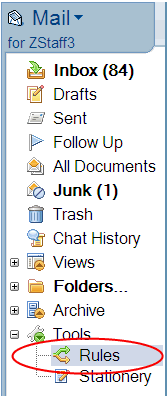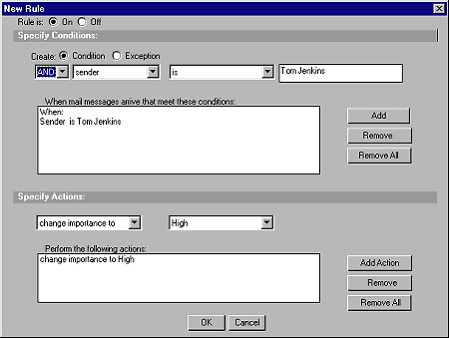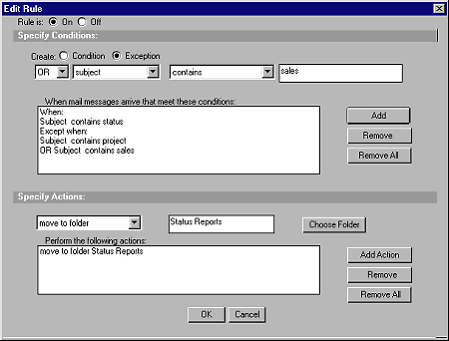| Filtering New Mail Using Rules |  |
You can use mail rules to have Notes act automatically on new messages you receive that meet certain conditions. For example, you could create a rule that checks for messages from a certain sender or that contain a certain subject and have Notes automatically move the messages to a certain folder.
Notes stores the mail rules you create in the Rules folder in your mail database. You can go there to add new rules as well as work on the ones you've created. For example, you can edit rules, change their order so that one rule has priority over another, turn them off when you don't want to use them, or delete them entirely. Click any of these topics:

To create a rule
1. Open your mail database and click the Rules folder.
2. Click "New Rule."
3. Under "Specify Conditions," select a part of messages to check (such as "sender" or "subject"), select a state (such as "contains" or "is"), and type the criteria to check for (such as the name of a certain person or a certain word).
For example, you could select "sender," select "contains," and type Alice to filter all messages sent to you by Alice French, Alice Sterns, and anyone else named Alice. Or you could select "Size (in bytes)," select "is greater than," and type 2000 to filter all messages sent to you that are greater than 2000 bytes.
4. Click Add.
5. Do any of the following:
 | What do you want to do? | Procedure |
 | Add more conditions | Select Condition, select "AND" or "OR," and repeat Steps 3 and 4 for each new condition. |
 | Add an exception | Select Exception and repeat Steps 3 and 4. |
 | Add more exceptions | Select Exception, select "AND" or "OR," and repeat Steps 3 and 4 for each new exception. |
 | Remove a condition or exception | Click it in the "When mail messages arrive" box and click Remove. |
 | Remove all conditions and exceptions | Click "Remove All." |
6. Under "Specify Actions," select "move to folder," "copy to folder," "change importance to," or "delete."
7. If you selected "move to folder" or "copy to folder," click "Choose Folder" and select a folder. If you selected "change importance to," select an importance level.
8. Click "Add Action."
9. Do any of the following:
 | What do you want to do? | Procedure |
 | Add more actions | Repeat Steps 6 through 8 for each new action. |
 | Remove an action | Click it in the "Perform the following actions" box and click Remove. |
 | Remove all actions | Click Remove All. |
10. Click OK.
Examples: Mail rules
The following rule automatically changes the importance of all messages from Tom Jenkins to high (which means they are displayed with an exclamation point in the Inbox to catch your attention):

The following rule automatically moves all messages that have the word "status" in the subject from the Inbox to the Status Reports folder unless the subject also has the word "sales" or "project" in the subject:

To manage rules
| What do you want to do? | Procedure |
| Enable or disable a rule |
|
| Edit a rule |
|
| Move a rule |
6. Open the Rules folder and click the rule.
7. Click "Move Up" or "Move Down" until the rule is where you want it.
8. Notes uses rules in the order in which they appear from top to bottom, so you can move the rules you want to have priority closer to the top. This way, if a new message you receive meets the criteria of two different rules, the rule that's closer to the top acts on the message first. (This is particularly important if you have rules that move or delete messages.)
|
| Delete a rule |
9. Open the Rules folder and click the rule. To delete more than one rule, click in the column to the left of each rule to select it.
10. Click "Delete Rule" to mark the rule for deletion. Notes displays a trash can next to the rule.
11. Press F9 to refresh the folder or close the folder.
12. Select Yes when Notes asks if you want to delete documents.
|
|